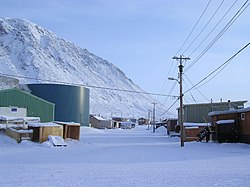Grise Fiord
|
Grise Fiord ᐊᐅᔪᐃᑦᑐᖅ Aujuittuq |
|
|---|---|
| Hamlet | |
 |
|
| Coordinates: 76°25′03″N 082°53′38″W / 76.41750°N 82.89389°WCoordinates: 76°25′03″N 082°53′38″W / 76.41750°N 82.89389°W | |
| Country | Canada |
| Territory | Nunavut |
| Region | Qikiqtaaluk Region |
| Electoral district | Quttiktuq |
| Settled | 1953 |
| Government> | |
| • Mayor | Meeka Kiguktak |
| • MLA | Isaac Shooyook |
| Area | |
| • Total | 332.7 km2 (128.5 sq mi) |
| Elevation | 41 m (135 ft) |
| Population (2016) | |
| • Total | 129 |
| • Density | 0.4/km2 (1/sq mi) |
| Time zone | EST (UTC-5) |
| • Summer (DST) | EDT (UTC-4) |
| Canadian Postal code | X0A 0J0 |
| Area code(s) | 867, Exchange: 980 |
| Website | www.grisefiord.ca |
Grise Fiord, (Inuktitut: Aujuittuq, "place that never thaws"; Inuktitut syllabics: ᐊᐅᔪᐃᑦᑐᖅ) is an Inuit hamlet in the Qikiqtaaluk Region in the territory of Nunavut, Canada. Despite its low population (129 residents as of the Canada 2016 Census), it is the largest community on Ellesmere Island. It is also one of the coldest inhabited places in the world, with an average yearly temperature of −16.5 °C (2.3 °F).
Located at the southern tip of Ellesmere Island, Grise Fiord is one of three permanent settlements on the island. Grise Fiord lies 1,160 km (720 mi) north of the Arctic Circle.
Grise Fiord is the northernmost civilian settlement in Canada, but Environment Canada has a permanent weather station, Eureka, and at Alert there is a permanent Canadian Forces Base (CFS Alert) and weather station, that lie further north on the island.
Grise Fiord cradles the Arctic Cordillera mountain range.
Grise Fiord means "pig inlet" in Norwegian and was named by Otto Sverdrup from Norway during an expedition around 1900. He thought the walrus in the area sounded like pigs. Grise Fiord's Inuktitut name is Aujuittuq which means "place that never thaws."
The population of Grise Fiord is declining, and consists of around 129 permanent residents, a decrease of 0.8% (1 person) from the 2011 census. The houses are wooden and built on platforms to cope with the freezing and thawing of the permafrost. Hunting is still an important part of the lifestyle of the mostly Inuit population. Quota systems allow the villagers to supply many of their needs from populations of seals, walruses, narwhal and beluga whales, polar bears and muskox. Ecotourism is developing as people come to see the northern wildlife found on Ellesmere and surrounding islands.
...
Wikipedia


